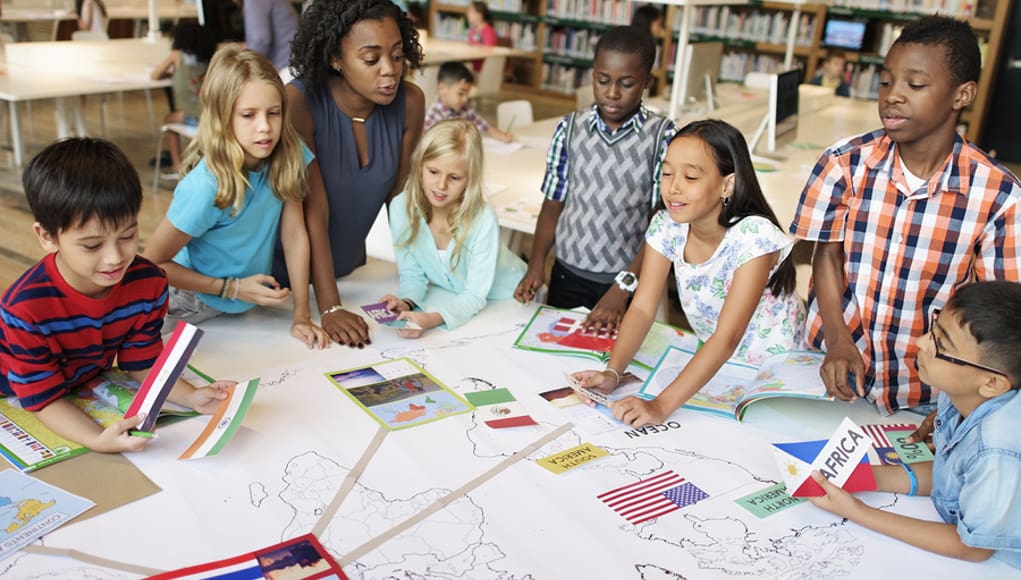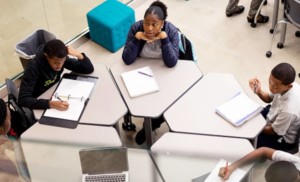Linking Global Knowledge, Project-Based Learning and the Pandemic: One School’s Journey

By: Dr. Margy Jones-Carey
The last few months have certainly been different across the world. Communities have had to respond to an unforeseen set of circumstances and as a result, schools, like many other “businesses” have had to “re-imagine” the way business is conducted. For years, we have been asking schools to engage in problem/project based learning. Professional development has been offered to teachers and many schools have embraced this way of creating projects that meet certain criteria such as: significant content, 21st-century skills, in-depth inquiry, responding to a driving question, the project answers a question of what you need to know, student voice & choice in the final project , reflection & revision, and presenting the culminating project to a public audience.
The current situation has allowed one western New York Charter School the opportunity to take the key elements of PBL and create a whole school (grades 9-12) project-based learning opportunity done through shared learning using technology in a fully online school setting. The school led by teacher leaders, created a project around past pandemics. The teacher leaders, along with their colleagues, determined the key elements that prior pandemics have had on different elements of society and transformed those elements into each of the subject areas taught by the school (including physical education, art, music, advanced courses). Those elements aligned with the subject areas were then cross walked to the NYS standards and required assessments. The teacher-led project was born!
The week before the project began, the administrative team rolled out via an all call phone system, which called every household, an introduction to the concept of the project and the timelines for the project. They also created a video announcement that was accessible to all students and families. Behind the scenes, teachers were creating shared folders using google classrooms, and were gathering examples of completed projects along with the key concepts to be addressed by the individual subjects ready to go. A calendar of work was designed on a weekly basis and each subject area has one week where their course work is the focus for students. Once the list of pandemics was approved by the teacher leadership group, a common template was created that all teachers used to distribute work to students.
Students have voice and choice in how they will present the elements of the project for each of the subject areas. The choices include investigative, artistic, realistic, social, conventional or enterprising. Each week teachers further refine these choices to align with the work of the subject area to ensure students have concrete examples that ensure clarity and success.
While students are working on the pandemic project for that subject area, they are also required to do some work for the other courses they are enrolled in. However, the time of day and the way in which each student approaches the work to be done, is determined by the students. Teachers track attendance each day through the completed individual subject “to do” work for today and scaffolded the work across the week.
Each subject area (one subject area per week) used the template (Social Studies is linked here as an example) for the requirements for the project. Teachers worked with students daily in small groups to answer questions, guide the development of the responses, and provided feedback to students. Students submitted the projects in shared folders so that all teachers can see the work of all students. Each week, a common rubric was used to ensure rigor and continuity in the work submitted. As the project concludes, students are to submit a reflective summary that discusses how the learnings of the project are related to the current situation they are living.
Each week teachers will be assigning grades to student submissions based on the common rubric. Once the individual weeks of work are concluded, students will be asked to submit a synopsis of the work completed to be reviewed. This synopsis is aligned with a key required element of project based learning which is a publishable project that is shared publicly. To ensure this occurs, students’ synopsis submission will be “publicly” viewed by teachers and students (if possible) online. An overall score on the project using the agreed upon rubric will be assigned.
As schools are asked to re-imagine education, Global Concepts Charter School in Lackawanna, New York has taken on the challenge by linking a professional development initiative from the 2019-2020 school year with a school-wide project that engages students in an investigative learning model based on historical events that are linked to the current situation we all find ourselves in. The perfect way to answer the questions that students consistently ask “Why do I have to know this?” or “How is this subject area linked to my everyday life?” Margy shares more on learning during a pandemic on EdWeek and the Washington Post.
Dr. Margy Jones-Carey is an educational consultant. You can find her on Twitter.
Stay in-the-know with innovations in learning by signing up for the weekly Smart Update.


0 Comments
Leave a Comment
Your email address will not be published. All fields are required.